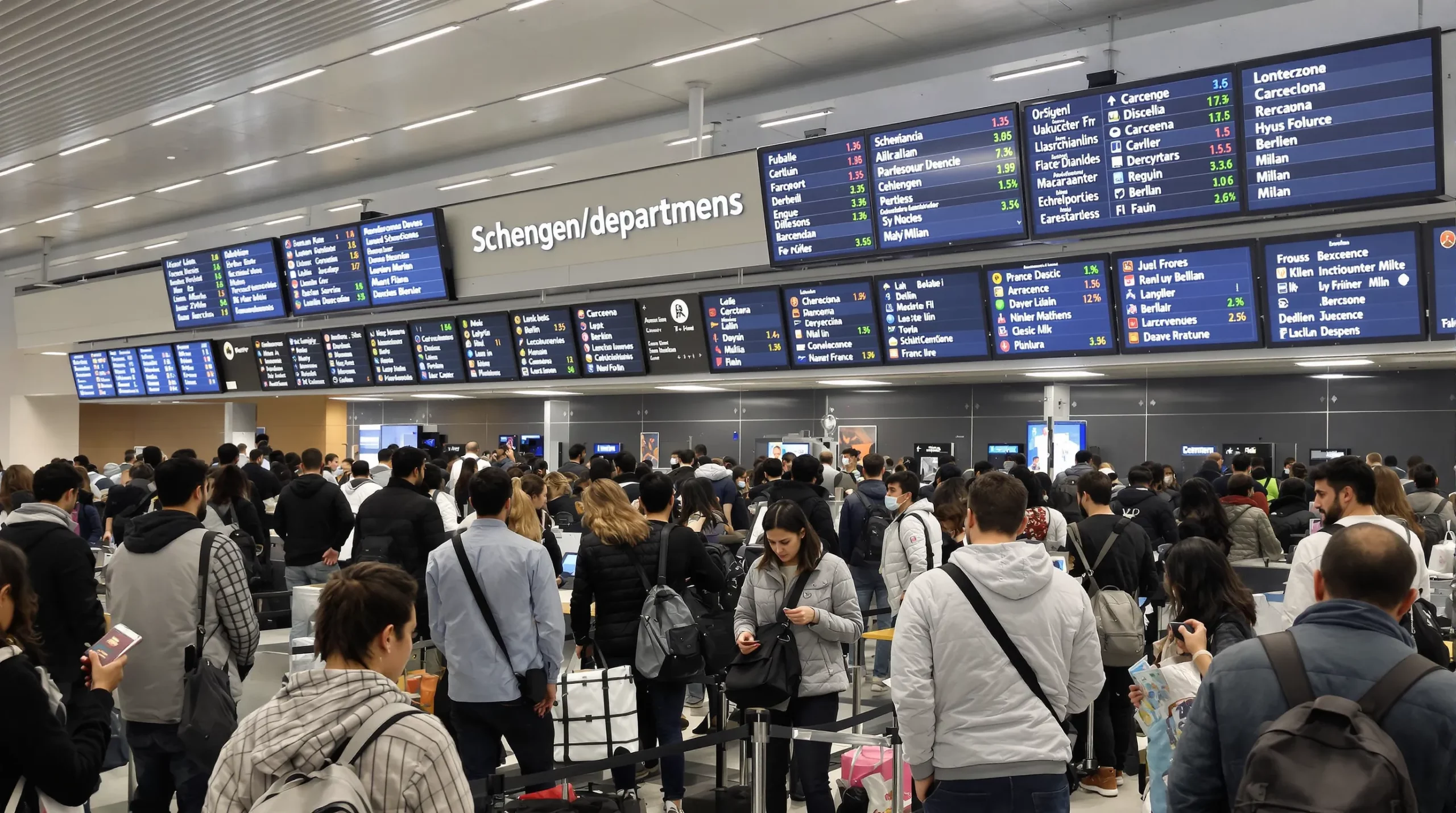Traveling Inside Schengen with a French Residence Permit: Rules and Tips

Traveling freely across borders is one of the biggest quality-of-life improvements that comes with holding a valid French residence permit. Yet many newcomers discover only at the airport check-in desk that “free movement” inside the Schengen Area is not unconditional. Below is a practical, 2025-updated overview of the rules that apply to third-country nationals residing in France, plus field-tested tips to keep your weekends in Barcelona or work trips to Berlin worry-free.
1. What the law actually says
Under Article 21 of the Schengen Borders Code, a third-country national who holds either :
- a long-stay visa marked “Visa D – valid as residence permit” (VLS-TS) issued by France, or
- a French residence permit (carte de séjour pluriannuelle, carte de résident, talent passport, family card, etc.)
may enter and circulate within the territories of the 26 Schengen member states for up to 90 days in any 180-day period, without applying for an additional visa.
The European Commission confirms this interpretation in its consolidated guidance of November 2023. Airlines and border guards are instructed to treat a residence permit exactly like a Schengen multi-entry visa for the purpose of short stays.
Key takeaway: think of your permit as a 90-day tourist visa that automatically renews as long as the card itself remains valid.
2. The 90/180 rule, demystified
The famous 90-day limit is cumulative across all Schengen countries. Day trips count as one full day, and the 180-day reference window is a rolling period counted backwards from each day of stay.
Example :
- 1–15 March 2025: vacation in Greece (15 days)
- 10–20 May 2025: conference in Germany (11 days)
- 1–20 July 2025: family visit in Spain (20 days)
Total used by 20 July 2025: 46 days. You would therefore still have 44 days available anywhere in Schengen until 27 August 2025.
Online calculators such as the EU’s official Schengen Calculator can help you avoid mistakes.
3. Countries you can and cannot visit on a French residence permit
| Category | Countries (August 2025) | Status for permit holders |
|---|---|---|
| Schengen members | Austria, Belgium, Croatia, Czechia, Denmark, Estonia, Finland, France, Germany, Greece, Hungary, Iceland, Italy, Latvia, Liechtenstein, Lithuania, Luxembourg, Malta, Netherlands, Norway, Poland, Portugal, Slovakia, Slovenia, Spain, Sweden, Switzerland | Free travel ≤ 90/180 |
| EU but not Schengen | Bulgaria (partial checks), Cyprus, Ireland, Romania (partial checks) | French residence permit not enough – short-stay visa may be required¹ |
| European microstates | Andorra, Monaco, San Marino, Vatican | Accessible through neighboring Schengen state, but passport checks possible |
| French overseas territories | Guadeloupe, Martinique, Réunion, etc. | Not in Schengen – your card alone does not exempt you from local visa formalities |
¹Romania and Bulgaria joined Schengen for air and sea borders only on 31 March 2024. Land crossings still involve controls, and airlines may demand a short-stay visa until full accession is completed.
4. Document checklist before you leave France
- Passport – must be valid at least 3 months beyond your planned return date and issued within the last 10 years.
- Original residence permit or VLS-TS sticker. Photocopies are not sufficient at the gate.
- Proof of French address (utility bill or digital attestation). Not mandatory, but often requested on budget airlines.
- Travel insurance covering medical emergencies up to €30 000. Many Schengen states still perform spot checks.
- Ongoing renewal receipt (récépissé) or prolongation sticker if your card expires during the trip.
Flying soon after filing for a renewal? French law grants an automatic 3-month extension, but only if the prefecture has given you a récépissé that expressly mentions international travel (“autorise le franchissement des frontières”). Without that wording, land routes are safer.
5. Common pain points – and how to avoid them
-
Airline desk ignorance
Some low-cost carriers train staff only on passports and classic Schengen visas. Bring a print-out of the French Interior Ministry’s FAQs or the EU Commission guidance (links below). It can save you a last-minute argument. -
Expired passport but valid permit
Your residence card does not replace a passport. Renew it first – most consulates in Paris now issue fast-track appointments for this reason. -
Lost or stolen card abroad
File a police report immediately, then contact the nearest French consulate for a return visa (visa de retour). ImmiFrance can coordinate the paperwork remotely if you have an active case file with us. -
Studying or working remotely outside France for more than 90 days
You will need either a local long-stay visa or an intra-EU mobility permit (directive 2016/801 for students and researchers, ICT for workers). Consult our work-permit guide early.
6. ETIAS and Entry/Exit System – will they change the game?
The EU Entry/Exit System (EES) is expected to go live in October 2025, followed by ETIAS in mid-2026. Both regulations explicitly exempt holders of long-stay visas and residence permits issued by a Schengen state. You will simply be registered automatically when crossing an external border; no online application or fee is foreseen for residents.
That said, digital kiosks may replace human stamping. Keep your card handy and allow extra time for the first trip after implementation.
7. Practical itinerary tips from 500 + client cases
- Choose direct flights whenever possible. Connecting in the UK or Ireland triggers a separate visa regime and additional border checks.
- Book with a French IBAN linked to your home address. Some hotels in Poland and Hungary still refuse third-country cards that lack embossed names.
- Travel in the first six months after card issuance if you plan to explore multiple destinations. Once you have accumulated more than 12 months of absences from France over a rolling three-year period, you risk issues at prefecture renewal time.
- Keep digital copies (encrypted cloud) of your residence card, passport, and proof of income. Consular help is faster when you can email documents.
- Leverage train travel. The Paris-Barcelona TGV, Paris-Milan Frecciarossa, and new Berlin Nightjet lines all cross Schengen internal borders without identity controls onboard, reducing the stress of unclear airline policies.

8. If your situation is less than straightforward
- Pending asylum or OQTF status: An OQTF (“obligation de quitter le territoire français”) suspends your right to re-enter France. Leaving the country can be considered voluntary departure and may bar you from returning. Seek legal advice first.
- Family members with different status: Your non-EU spouse or child who does not hold their own French permit must either 1) apply for a visa for each trip or 2) secure a carte de séjour « vie privée et familiale » before departure. Mixed-status families account for 18 percent of the last year’s refusals at Schengen entry points, according to Frontex.
ImmiFrance can review the whole household’s documents and book joint prefecture appointments, sparing you hours of queueing.
9. Sources you can cite at the border
- European Commission, Handbook on Travel for Residence Permit Holders (rev. 11/2023)
- French Ministry of the Interior, Questions-réponses sur le droit au séjour (updated 03/2025)
- Regulation (EU) 2016/399, Schengen Borders Code (consolidated 01/2024)
Having these PDFs on your phone can be persuasive when an airline supervisor is unfamiliar with third-country rules.
10. Ready for take-off? How ImmiFrance can help
Whether you need a last-minute récépissé for your Croatian beach holiday or long-term planning for a pan-European work schedule, our team of immigration attorneys and former prefecture officers is a click away.
- Personalized document audits within 48 hours
- Live chat while you are at the border
- Full representation for residence-permit renewals if cumulative travel days raise red flags
Visit our residence-permit hub or schedule a free 15-minute call today. Your French address may be fixed, but your horizons don’t have to be.

